The continuous monitoring of vascular health achievable by implantable electronics can offer improved disease diagnosis and treatments. We developed a wireless nanomembrane system consisting of a smart stent and soft sensors to enable simultaneous monitoring of blood pressure, blood flow, and pulse rate.
Vascular diseases, which impact arteries and the heart, account for more than 30% of deaths across the world and are the leading cause of death. These diseases encompass cardiovascular diseases, hypertension, atherosclerosis, aneurysm, and more. Hemodynamics, which are measurements related to the flow of blood, are of great interest when diagnosing, monitoring, and treating vascular diseases. The current standard procedures to measure hemodynamics, including angiography, medical imaging, and catheterization, offer an incomplete view of patient health and require repetitive procedures and clinical visits for long-term monitoring. We remark that while implantable electronics have been developed to address the need for continuous monitoring, they are currently restricted to measuring pressure in a few locations due to device designs and materials incompatible with implantation in many arteries.
To advance patient care, we introduce an adaptable solution for comprehensive monitoring of hemodynamics using a stent-based platform integrated with soft sensors. Stents are a mesh-like tube that are currently implanted more than 3 million times per year to treat vascular diseases, such as during angioplasty and stenting to treat atherosclerosis. Stents are implanted via a minimally invasive procedure of catheterization where a trained doctor guides the stent within arteries via flexible tubing to access the vascular system. With this background, stents offer a convenient platform to use for implantable sensors. To take advantage of the existing stent devices and procedures, we have redesigned a stent to operate as a wireless antenna for sensors without compromising medical functionality. Integrated with this smart stent are soft sensors that seamlessly conform with the stent to monitor blood pressure, blood flow rate, and pulse rate. The integrated stent and sensor system is low-profile and implantable by standard catheter procedures to enable unobtrusive, continuous wireless monitoring from an external antenna.
To create the wireless stent, we designed a multi-material stent structure combining conductive materials (stainless steel and gold) and nonconductive materials (polymers). The conductive materials formed an antenna while the nonconductive materials provided critical mechanical support to the stent. A laser-machining process was developed to fabricate the smart stent. Soft, highly flexible sensors were fabricated using a rapid printing process to allow for measuring pressure, flow rate, and pulse. Sensors were laminated on the stent surface and electrically connected along the stent to form the integrated device.
We then performed a series of tests to evaluate the wireless implantable stent and sensor system. First, we characterized the performance of the smart stent. Our first question was if the smart stent can sufficiently replace a conventional stent. We found the multi-material stent design replicates the key mechanics of conventional stents needed to keep arteries opened. The smart stent can be implanted and expanded with a balloon catheter. Our second question was if the stent could perform as a wireless antenna. The stent exhibited wireless communication to allow for transfer of sensor information to an external antenna. For integration with the stent platform, soft and miniaturized sensors were formed with the use of a rapid and high-throughput printing process. We found the sensors demonstrated excellent flexibility and durability, which are key criteria for enduring implantation and operation in narrow arteries.
The implantable system was characterized in vitro in an artery model. An antenna communicated with the device and allowed for monitoring of blood pressure, flow rate, and pulse rate from a single stent. We also demonstrated feasibility of catheter implantation in vivo with a live animal study where the wireless device was successfully implanted by catheter into an artery of a rabbit.
Based on our results, the design, materials, and fabrication strategies from this study provide wide opportunity to advance implantable vascular electronics and transform the care of vascular diseases. Future work may include developing ultra-thin sensors with thinner and stronger smart stents to improve the system. While the demonstrations included monitoring of a few hemodynamics, the advancements can be readily extended for a broad range of vascular sensors. For example, disease-specific devices may be developed, such as monitoring a common problem known as restenosis where atherosclerosis reoccurs after stenting. Overall, the device design offers great potential and a highly adaptable platform for vascular electronics to be further explored and to enhance the way we treat and monitor vascular diseases.
Original Article:
Herbert, R., Lim, H.-R., Rigo, B., & Yeo, W.-H. (2022). Fully implantable wireless batteryless vascular electronics with printed soft sensors for multiplex sensing of hemodynamics. Science Advances, 8(19). https://doi.org/10.1126/sciadv.abm1175
 Maths, Physics & Chemistry
Maths, Physics & Chemistry



